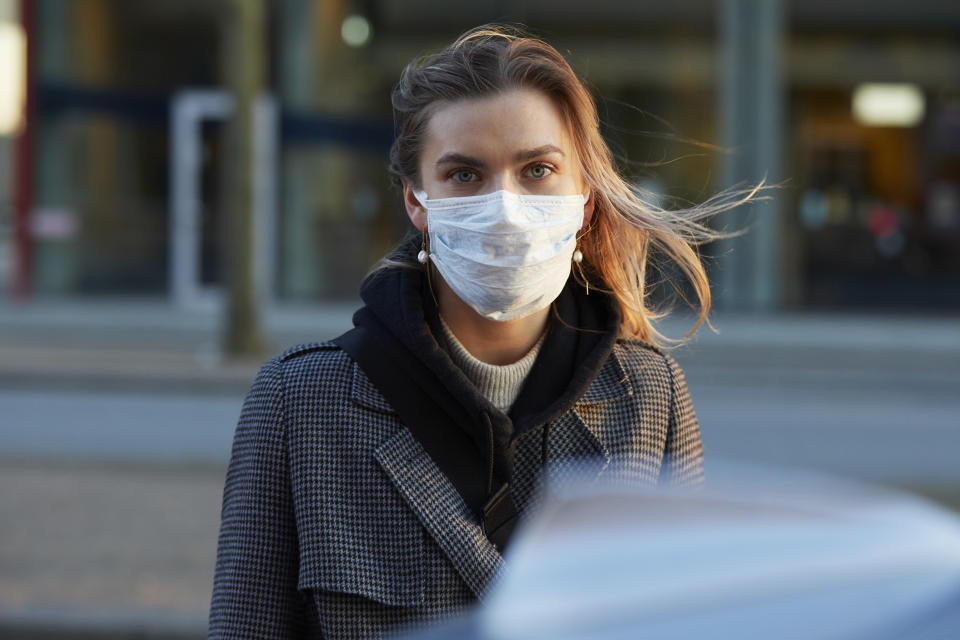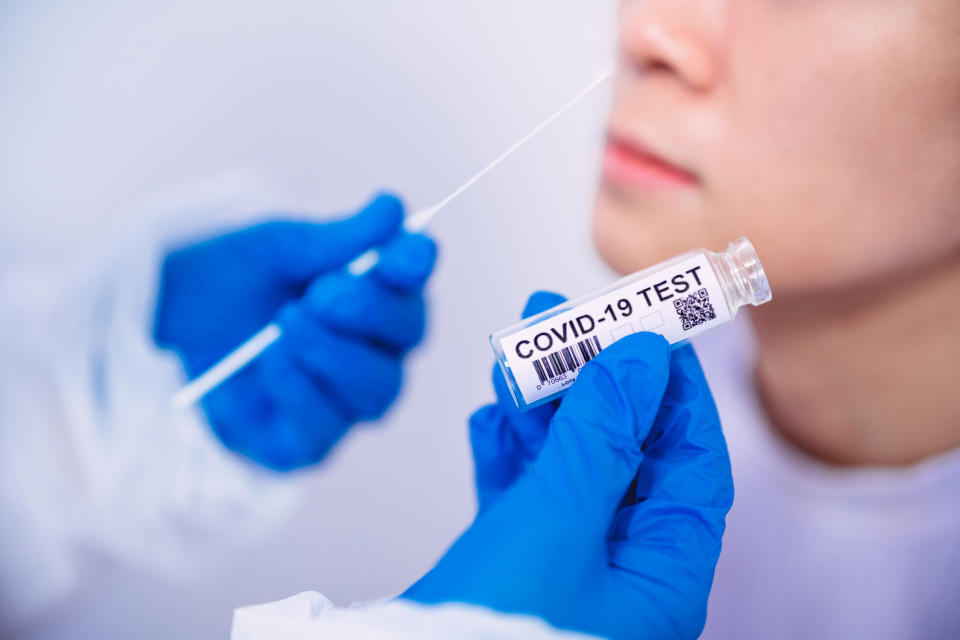Coronavirus cases doubling every seven to eight days in England, study suggests

A “robust” new report suggests coronavirus infection rates are growing steadily across England.
Scientists from Imperial College London looked at the test results of more than 300,000 volunteers between 24 July and 7 September, as part of the country’s largest study into the outbreak.
From 22 August to 7 September, cases doubled every seven to eight days, results suggest.
The scientists estimate 13 in every 10,000 people were infected in England in the latter part of their research, compared to four in every 10,000 between 24 July and 11 August.
Read more: Coronavirus risk highest among cleaners in one NHS trust
They have stressed their results reinforce the need for continued vigilance, with social gatherings being limited to six people from multiple households as of 14 September in England.
The results come as the Office of National Statistics reveals there were 3,200 new confirmed coronavirus cases a day in England during the first week of September, compared to 2,000 the week before.

“Our large and robust dataset clearly shows a concerning trend in coronavirus infections, where cases are growing quickly across England and are no longer concentrated in key workers,” said study author Professor Paul Elliott.
Read more: One in 100 hospitalised COVID patients in UK has a punctured lung
“What we are seeing is evidence of an epidemic in the community and not a result of increased testing capacity.
“This is a critical time and it’s vital the public, our health system and policy makers are aware of the situation as we cannot afford complacency.”
Watch: Yahoo UK’s Health Correspondent, Alexandra Thompson explain how coronavirus is treated
Cases doubled every 7.7 days
As part of their React-1 study, the Imperial scientists randomly selected people over five years old in England.
The volunteers provided nose and throat swabs, which revealed whether they were actively infected with the coronavirus at that time.
From 22 August to 7 September, more than 150,000 people took part, with 136 swabs coming back positive.
The scientists calculated the rate of coronavirus infection doubled every 7.7 days during the 16 day period.
Read more: Doctor describes ‘bone-deep weariness’ of working amid a pandemic
Unlike in May and June, the results – which are preliminary and not published in a medical journal – suggest coronavirus cases are no longer clustering in hospitals or care homes, with the infection now spreading more readily in the community.
The results also found no significant difference in the prevalence of infection between key workers and the general public.
Overall, infections were found to be increasing across all adult age groups under 65, but particularly among 18 to 24 year olds, where 0.25% tested positive – up from 0.08% between 24 July and 11 August.
The results suggest the coronavirus is on the rise across all areas of England, but is most marked in Yorkshire and the Humber, the north west (both 0.17%) and the north east (0.16%).
Statistics flagged early in the outbreak people of black, Asian or ethnic minority (BAME) backgrounds were more likely to develop coronavirus complications.
The Imperial scientists found the rate of infection was highest among the black or Asian volunteers, where 0.2% tested positive. The rate among the mixed ethnicity participants was 0.16%, rising to 0.23% for the other ethnicities.
This is compared to 0.08% among the white participants.
The scientists also found nearly two thirds (65%) of the positive cases did not report any symptoms at the time of the swabs or the week before.
The rate of asymptomatic infection has been debated throughout the outbreak. Some argue if a patient is not coughing or sneezing – both coronavirus symptoms – they would be expected to pass the virus on less readily.
Read more: Steroids could cut risk of death by a fifth in critically-ill COVID patients
Recent contact with a known coronavirus case was associated with a higher rate of infection at 2.74%, compared to 0.08% for no known contact, the Imperial scientists found.
The results also suggest a reproduction (R) number of 1.7. This is the number of people a patient statistically goes on to infect. When R is more than one, an outbreak grows.
The R rate has caused some confusion, however, with the government rating it between 1 and 1.2 across the UK.
According to the government-funded COVID Symptom Study app, R is 1.3 in England, 1.2 in Scotland and Wales, and 1.1 in Northern Ireland.
“If the R number is as high as 1.7, as this data suggests, then we could be at risk of being almost back at square one in terms of our ability to contain the virus,” said Dr Simon Clarke, from the University of Reading.
“This is a massive blow to the government’s strategy to contain the spread of COVID-19 [the disease caused by the coronavirus].”
‘The pandemic is not over’
The latest report – the third from Imperial’s React-1 study – was commissioned by the Department of Health and is one of several the government is using to influence its decision making amid the pandemic.
From 14 September, people in England will only legally be allowed to meet socially in groups of up to six in any indoor or outdoor setting, including homes, restaurants and pubs.
Exemptions include organised sports events, weddings and funerals. The Imperial scientists have stressed social distancing is important even when meeting in small groups.
The World Health Organization has warned young people may be driving coronavirus spikes across Europe. With the risk of complications increasing with age, some worry younger generations are not taking social distancing seriously.
In Sweden, cases among people under 49 have been declining since mid-June, however, the 20 to 29 age group has more incidences per 100,000 than any other cohort in the country.
As of 28 July, nearly six in 10 (60%) confirmed coronavirus cases in Ireland were in people under 45.
“We’ve seen all across the world how a rise in cases, initially among younger people, leads to hospitalisations and fatalities,” said health secretary Matt Hancock.
“The pandemic is not over, and everyone has a role to play to keep the virus at bay and avoid another further restrictions.
“It’s so important everyone abides by the law and socialise in groups up to six, make space between you and those outside your household, get a test and self-isolate if you develop symptoms and wash your hands regularly.
“It is vital you engage with NHS Test and Trace service if contacted to provide details of your close contacts and self-isolate if you are asked to do so.”

Dr Zania Stamataki from the University of Birmingham added: “The concerning increase in cases over September compared to the summer months is not unexpected given fewer restrictions, but the health and social care secretary is right: there are simple actions each of us can take immediately to limit transmission and we must take personal responsibility.
“There is a real risk the surge in cases, even amongst the young, will soon translate to increased hospitalisations of the vulnerable.
“We must all take action to limit transmission because we still cannot predict with certainty who will succumb to disease and who will suffer from debilitating ‘long COVID’ for months to come; it is not a simple matter of shielding our elderly.
“The study found 65% of positive samples came from asymptomatic or pre-symptomatic people, which shows how important it is to be vigilant as individuals because we don’t know our COVID status for certain even if we feel fine.
“The best thing to do is act like we are potential carriers and keep our distance, and wear face coverings in public places to protect those around us.”


